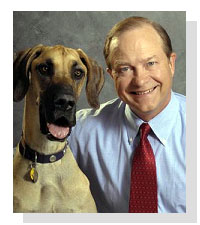Pet Podcasts
- Teacher's Pet
- Oh Behave !!
- Wings 'n Things
- The Pet Doctor
- Travel Tails
- Doggy Dog World
- Lucky's Stars
- Horsing Around
- PetLifeVideo
- Animals Speak
- Pet Peeves
- Cattitude
- Take Me Home
- Pets In The City
- Paranormal Pets
- The Pet Set
- PetTalk Naturally
- Hollywood Pets
- Lizard Lounge
- Off The Hook
- What Were
You Thinking
Check Out






Dr. Jim Humphries
President and News Director
Veterinary News Network

Veterinarians at Home Fight the War on Terror!
 ......................................................................
......................................................................
The safety of our food supply depends on the dedication and skills of veterinarians across the continent. However, concerns about terrorist attacks on this vital, yet vulnerable segment of our economy is prompting a review of security practices and the news appears bleak. Estimates from veterinary schools and veterinary leadership show that 4 out of every 100 jobs in public health or large animal health will go unfilled within the next several years. Watch this video to see how veterinarians continue to keep us safe from Mad Cow, Anthrax, and other deadly diseases.

Since the horrors of September 11, 2001, we are all acutely aware of the devastation associated with terror attacks. Organizations from our local police to the FBI and National Guard continue to upgrade plans to protect us and our borders. But who oversees our defenses against germs, bugs and other things too small to notice? Who is on watch against Mad-Cow disease, anthrax and food contaminants?
Soon after the terror bombings in New York and Washington, another threat surfaced. Letters containing anthrax, a deadly bacterium, were sent to Senate offices and news media offices, killing five people and infecting 17 more. These incidents focused attention on the potential risks of bio-terror attacks and the need for a coordinated system of response. Due to its high mortality and ease of transmission, anthrax is considered a risk to national security by the Centers for Disease Control.
Because of their background in zoonotic diseases, veterinarians are increasingly important to national security and public health. By recognizing diseases in animals, our veterinarians can often prevent illness in humans and minimize the loss of animal life. The recent foot and mouth disease outbreaks in Great Britain symbolize how essential veterinarians are to protecting the health of the nation. And often, veterinarians are the only ones trained to recognize these diseases and threats.
Biological agents not only cause death and suffering to humans, but they also devastate our livestock herds and can have a huge economic impact. Even rumors of disease can cause problems. A suspected foot and mouth outbreak here in North America cost the beef industry more than $50 million, even though the situation was a false alarm and the disease was never found. One has only to look to Asia to see how a single disease can cause chaos. Avian influenza has affected millions of birds across Asia, Africa and Europe and continues to upset human lives with its high mortality rate.
Veterinarians are instrumental in sounding the early warning system, but a decrease in the number of veterinarians treating large animals and working in the public health sector could make us vulnerable. The New York Times reports that less than 4,500 of the 75,000 veterinarians in the US are considered to be large animal doctors and that number continues to drop. Less than 6 percent of new graduates choose to treat large animals and fewer than 2 percent end up working for federal or state governments. Lower salaries, long hours, and potential for injury have kept many would-be livestock veterinarians in the small animal realm. All of this is happening at the same time that 75 percent of all emerging diseases in people are transmitted from animals.
Legislation has been enacted which authorizes the federal government to pay off education loans of veterinary students who opt for working in rural areas or in underserved careers, such as public health. Unfortunately, the law is not funded at this time.
Demand for large animal veterinarians should increase 12-13 percent over the next several years, but veterinary organizations and schools expect 4 out of every 100 jobs won’t be filled. Some states, like Kentucky, note that 25 of their 125 counties lack any large animal veterinarians.
So, when all is said and done, who is really on the front lines protecting us from West Nile Virus, and monkey-pox? Who can spot plague or brucellosis and recognize it for what it is? Well, it’s still the same person who has been doing the job for decades, the veterinarian. The question now is how can we provide reinforcements?
Government officials and experts continue their work at resolving the shortage of veterinarians in the public health sector. Newer legislation is being considered, but funding will remain an issue. To learn more about this ongoing national concern, visit www.MyVNN.com to see a video.




